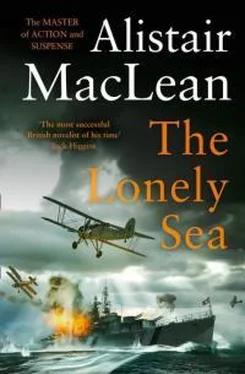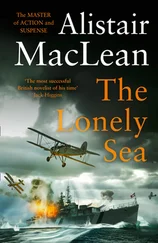Three hundred miles to the south, Vice-Admiral L. E. Holland’s squadron, consisting of HMS Hood, HMS Prince of Wales and six destroyers, were already steaming west-northwest at high speed on an interception course. The excitement, the anticipation aboard these ships was intense. For them, too, it was the end of a long wait. There was little doubt in anybody’s mind that battle was now inevitable, even less doubt that the battle could have only one ending, that the Bismarck, despite her great power and fearsome reputation, had only hours to live.
With her ten 14-inch guns to the Bismarck ’s eight 15-inch the Prince of Wales herself, our newest battleship, was, on paper at least, an even match for the Bismarck. (Only her commander, Captain Leach, and a handful of his senior officers were aware that she was far too new, her crew only semi-trained, her 14-inch turrets, as new and untried as the crew itself, so defective, temperamental and liable to mechanical breakdown that the builders’ foremen were still aboard working in the turrets, desperately trying to repair the more outstanding defects as the battleship steamed towards the Bismarck. )
But no one, not even the most loyal member of her crew, was staking his faith on the Prince of Wales. And, indeed, why should he, when only a few cable lengths away he could see the massive bows of the 45,000-ton Hood thrusting the puny waves contemptuously aside as she raced towards the enemy. When the Hood was with you, nothing could ever go wrong. Every man in the Royal Navy knew that.
And not only in the Navy. It is seventeen years now since the Hood died but none of the millions alive today who had grown up before the Second World War can forget, and will probably never forget, the almost unbelievable hold the Hood had taken on the imaginations and hearts of the British public. She was the best known, best loved ship in all our long naval history, a household name to countless people for whom Revenge and Victory were only words. The biggest, most powerful ship of the line in the inter-war years, she stood for all that was permanent, a synonym for all that was invincible, held in awe, even in veneration. For millions of people she was the Royal Navy, a legend in her own lifetime…But a legend grows old.
And now, with the long night’s high-speed steaming over, the dawn in the sky and the Bismarck looming up over the horizon, the legend was about to end forever.
Safely out of range, but with a grandstand view of the coming action, the men of the Norfolk and the Suffolk watched the Hood and the Prince of Wales, acting as one under the command of Vice-Admiral Holland, bear down on the Bismarck and the Prinz Eugen . But even at that distance it was obvious that the two British ships were too close together, that Captain Leach of the Prince of Wales was being compelled to do exactly as the Hood did instead of being allowed to fight his own ship independently and to the best advantage, and, more incredibly still, that the closing course, their line of approach to the enemy, was all that a line of approach should not be. They were steering for the enemy at an angle broad enough to present the Germans with a splendid target but, at the same time, just acute enough to prevent their rear turrets from being brought into action, with the result that the Bismarck and Prinz Eugen were able to bring their full broadsides to bear against only half of the possible total of the British guns.
Even worse was to follow. The Hood was the first to open fire, at 5.52 a.m., and, for reasons that will never be clearly known, she made the fatal error of concentrating her fire on the Prinz Eugen, and did so throughout the battle. The mistake in identification was bad enough, but no worse than the standard of her gunnery: the Prinz Eugen emerged from the action unscathed.
The Bismarck and Prinz Eugen, consequently, were free to bring their entire armament to bear on the Hood, who, because of her approach angle, could only reply with her two fore turrets. True, the Prince of Wales had now opened up also, but the blunt and bitter truth is that it didn’t matter very much anyway: her first salvo was more than half a mile wide of the target, the second not much better, and the third also missed. So did the fourth. And the fifth.
The Germans did not miss. The concentrated heaviness of their fire was matched only by its devastating accuracy. Both were on target – the Hood – almost at once, the Prinz Eugen ’s 8-inch shells starting a fire by the Hood ’s mainmast within the first minute. The Bismarck, too, was hitting now, the huge 15-inch projectiles, each one a screaming ton of armour-piercing steel and high explosive, smashing into the reeling Hood and exploding deep in her heart. How often the Hood was hit, and where she was hit we will never know, nor does it matter.
All that matters, all that we do know, is what was seen by the survivors of that battle at exactly six o’clock that morning, as the fifth salvo from the Bismarck straddled the Hood. A stabbing column of flame, white and orange and blindingly incandescent, lanced a thousand feet vertically upwards into the grey morning sky as the tremendous detonation of her exploding magazines almost literally blew the Hood out of existence. When the last echoes of the great explosion had rolled away to lose themselves beyond the horizon and the smoke drifted slowly over the sea, the shattered remnants of the Hood had vanished as completely as if the great ship herself had never existed.
So, in the twenty-first year of her life, the Hood died. This, the first naval engagement of her long life, had lasted exactly eight minutes, and when she went down she took 1,500 officers and men with her. There were three survivors.
The destruction of the Hood, the invincible, impregnable Hood, came as a tremendous shock both to the Navy and the country at large. It was incredible, it was impossible that this had happened – and the impossible had to be explained away, both verbally and in print, with all speed.
As details of the action were at that time lacking, no mention was made of the Hood’ s suicidal angle of approach to the enemy, the fatal mistake in identification that led to her firing on the Prinz Eugen instead of the Bismarck, or of the fact that the standard of her gunnery was so poor that she failed to register even one hit throughout the entire engagement. Perhaps it was as well that these things were not known at the time.
The reasons that were advanced at the time – and the source of inspiration of these reasons is not far to seek – were that the Hood, of course, had been no battleship but only a lightly-protected battle cruiser, and, even so, that the 15-inch shell that had found her magazine had been one chance in a million. These explanations were utter nonsense.
True, the Hood was technically classed as a battle cruiser, but it was just that, a technicality and no more: the fact is that with her 12-inch iron and steel sheathing extending over 560 feet on either side and with her total weight of protective metal reaching a fantastic 14,000 tons, she was one of the most heavily armoured ships in the world. As for the one chance in a million shell, senior naval architects had been pointing out for twenty years that the Hood ’s magazines were wide open to shells approaching from a certain angle, a danger that could easily have been obviated by extra armour plating. The Hood’ s design was defective, badly defective, and the Admiralty was well aware of this.
Читать дальше












